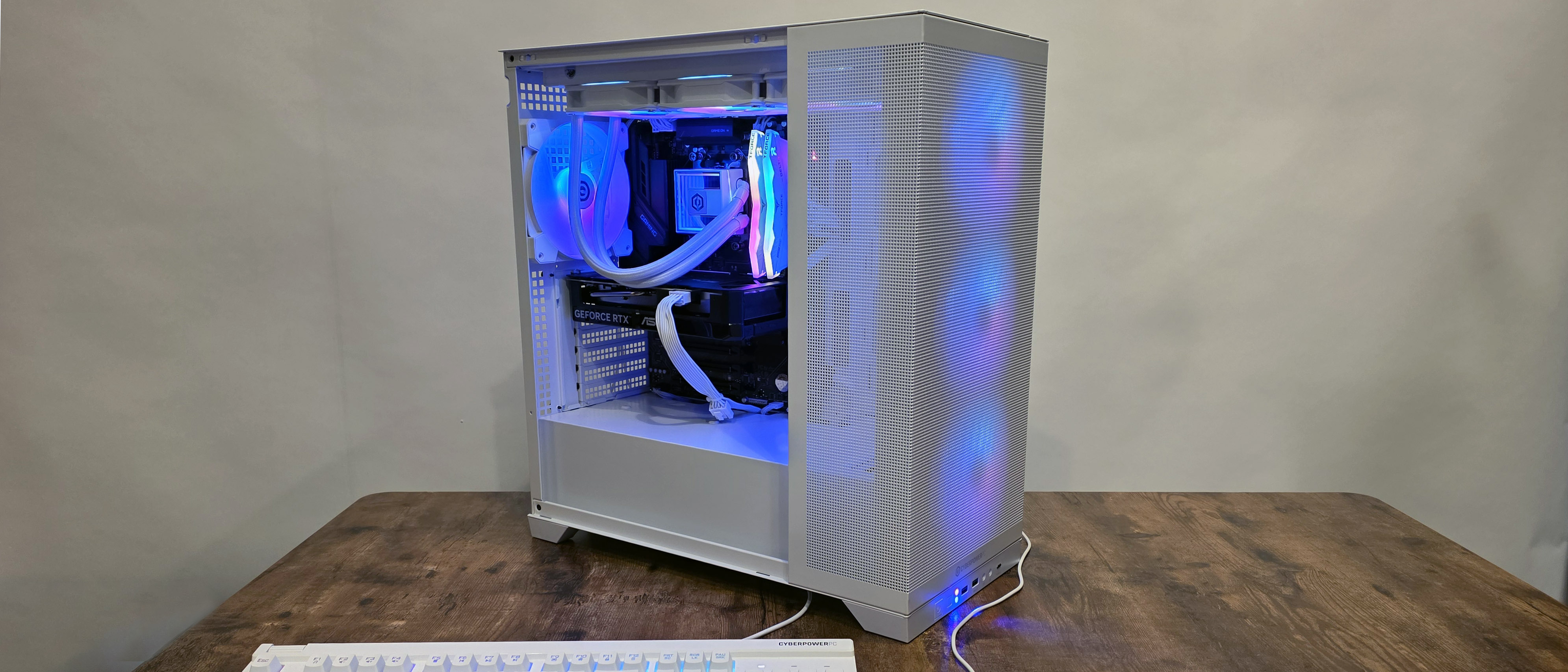Tom's Hardware Verdict
If you don't want to spend thousands on something more powerful, CyberpowerPC's Gamer Supreme delivers good mainstream gaming performance in a quiet, pale package, with matching peripherals.
Pros
- +
Solid, quiet gaming performance
- +
Mostly white build
- +
PSU has some headroom for a GPU upgrade
- +
Included peripherals are a step above the competition
Cons
- -
Fit and finish of the case could be better
- -
Keyboard looks nice, but isn't mechanical
- -
Bottom-mounted ports pretty much necessitate on-desk placement
Why you can trust Tom's Hardware
Between the high price of top-end GPUs, ever-evolving tariff pressures, and just general inflation, it's easy to get put off from PC gaming when it seems like every new rig costs several thousand dollars. But companies like CyberPowerPC have long specialized in delivering the best bang for your PC gaming buck (particularly when you don't want to build your own PC), and systems that are on the more affordable end of the spectrum.
And that's exactly what the Gamer Supreme SLC11260CPG is: a mainstream gaming tower that pairs AMD's best CPU for gaming with a 16GB RTX 5060 Ti for solid 1440p and 1080p performance at a sub-$2,000 price that feels downright affordable these days. The fact that it also comes in a white case with a matching 360mm AIO and peripherals is a nice touch if you don't like basic black.
Of course, there are some drawbacks that come with this system's affordability. The case isn't as premium as you'll find with competitors like the Corsair Vengeance a7500. And don't expect cutting-edge connectivity: USB on the back tops out at 5 Gbps; the Ethernet port is good-old Gigabit; and the wireless chip tops out at Wi-Fi 6.
And obviously, you won't be playing modern games at 4K on this system unless you're willing to turn the settings way down or software tricks like Multi Frame Generation way up. But so long as you keep your performance expectations in check, the CyberPowerPC Gamer Supreme is a very good option for those who want a gaming PC without paying more than $2,000.
CyberPowerPC Gamer Supreme (SLC11260CPG) specifications
CPU | AMD Ryzen 7 9800X3D |
Motherboard | Gigabyte B850 Gaming WIFI6 |
Memory | 32GB Team T-Force Delta DDR5-6000 (2x 16GB) |
Graphics | Asus GeForce RTX 5060 Ti |
Storage | 2TB Adata Legend 800 Gold PCIe 4.0 SSD |
Networking | 1 Gbps Ethernet, Wi-Fi 6 (Realtek RTL8851BE), Bluetooth 5.3 |
Front Ports | 2x USB 3.0, 1x USB 3.2 Gen 2 Type-C, 3.5 mm headphone and microphone jacks |
Rear Ports | 1x PS/2, 4x USB 2.0 Type-A, 4x USB 10 Gbps Type-A, 1x USB 10 Gbps Type-C, 3x audio jacks, 2x antenna ports |
Video Outputs | 3x DisplayPort, 1x HDMI |
Power Supply | High Power 850W non-modular |
Cooling | CyberPowerPC Bitspower Infinity 360 mm AIO |
Operating System | Windows 11 Home |
Dimensions (WxDxH) | 19.5 x 9.3 x 18.1 inches |
Price as Configured | $1,859.99 |
Design of the CyberpowerPC Gamer Supreme
If you like white PCs that include RGB, then the Gamer Supreme should appeal to you – just don't look too close. The front and part of the side are mesh, which is good news for airflow, while a glass panel gives you a decent look at what's inside. There are seven matching white RGB fans, three of which are on the 360 mm AIO, which is also white. But that's where the color matching ends, as the GPU and MSI motherboard are both black.
The case that CyberPowerPC chose is decent in terms of airflow, but it could be a bit nicer. It has mesh where it counts f, but the areas where panels meet at the corners aren't as flush as I'd like. See the top seam in particular in the image below. It's not awful, and you might be spending more time looking through the side window at the internal components. But the best PC cases are certainly nicer than what comes with this system – even our budget picks.
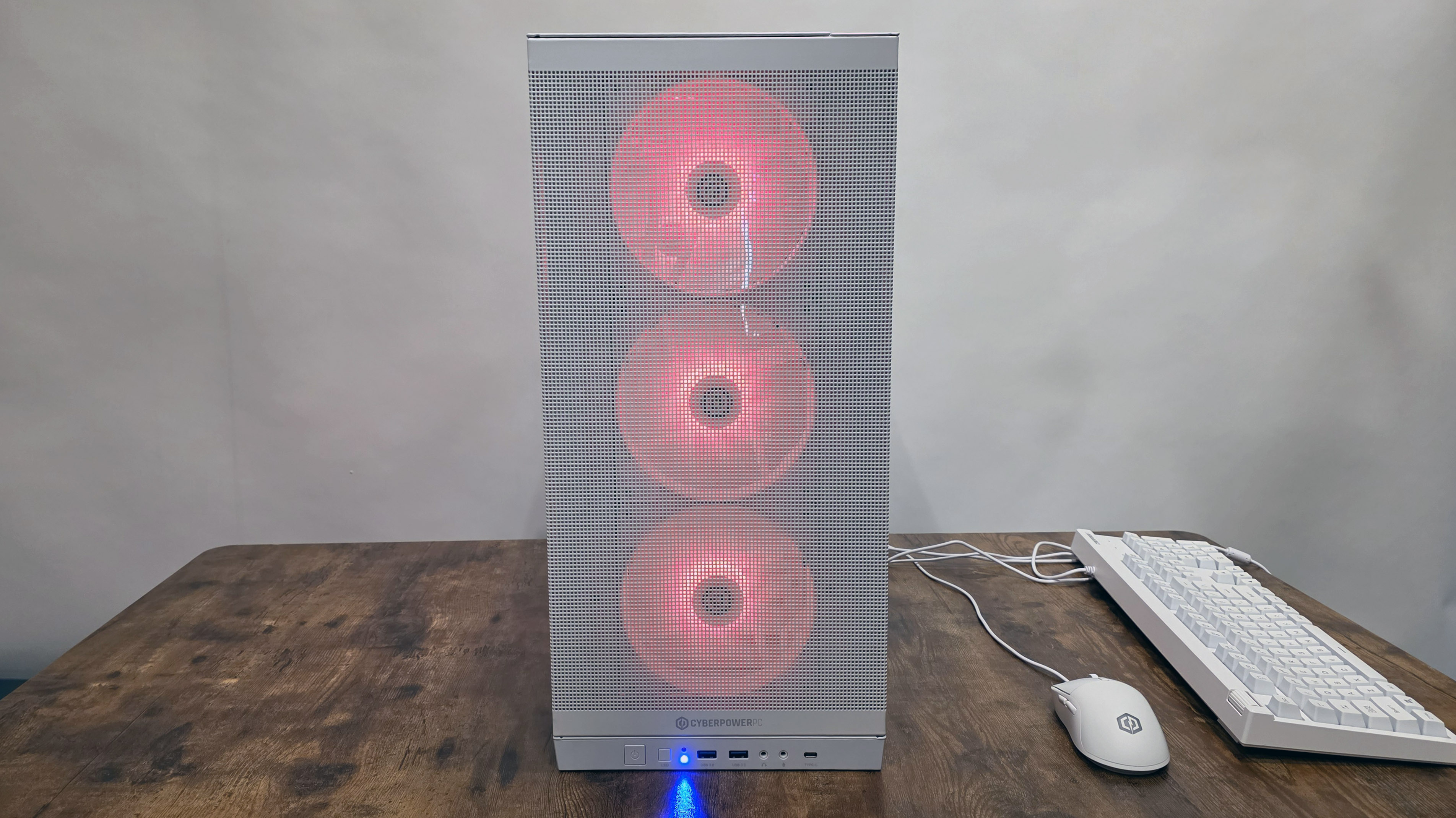
There are seven RGB fans, though, and a button in the front lets you control the lighting without having to deal with clunky software. There's something to be said for being able to press one button to cycle through colors on all the fans at once. That said, those color changes don't work with the included peripherals.
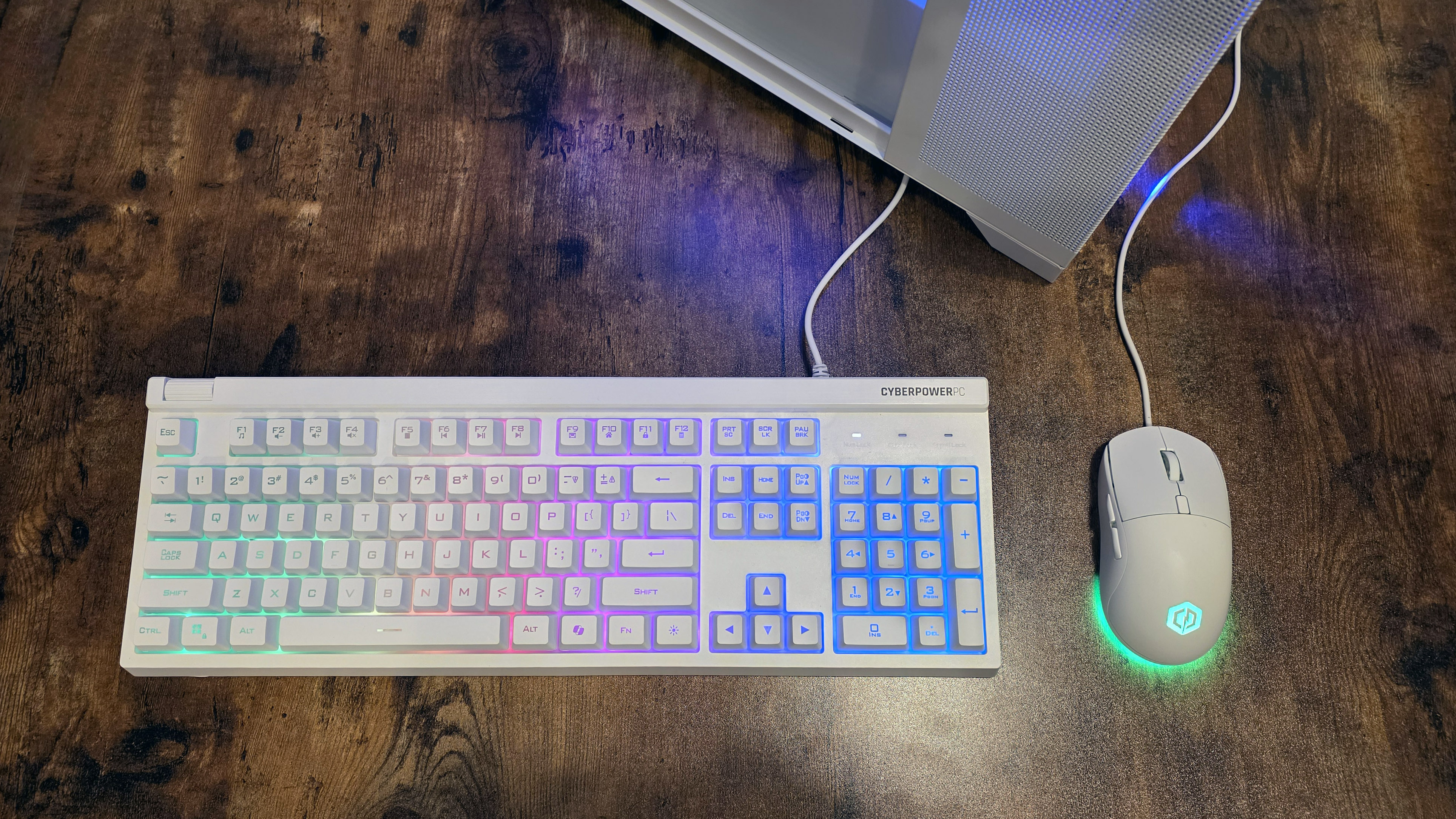
The company includes a keyboard and mouse that are also white, and they are a step or two above the pack-ins you get with most big-name brands (I'm looking at you, Alienware Area-51). The mouse in particular feels pretty good, and has some heft that helps it avoid feeling cheap. The keyboard also looks good, with RGB lighting and a volume rocker on the left. But while it felt OK to type and game on, this is a membrane keyboard, not mechanical. And both peripherals are wired. Considering there are decent mechanical keyboards that cost less than $50 these days, it would be nice to get something better in the box, but what CyberPowerPC includes with the Gamer Supreme is still better than what's included with most of the competition.
Ports and Upgradeability on the CyberpowerPC Gamer Supreme
Aside from the power and RGB lighting buttons on the front, the Gamer Supreme also has a pair of 5 Gbps USB-A ports, a 5 Gbps USB-C port, and separate headphone and mic jacks. Their placement on the front bottom of the case pretty much necessitates that you put the case on your desk if you want to use them, though. Personally, I prefer these ports up top.
The Gigabyte B850 Gaming WIFI6 motherboard in our review unit has two empty M.2 slots and four SATA if you want to add to the included 2TB ADATA PCIe 4.0 M.2 boot drive.
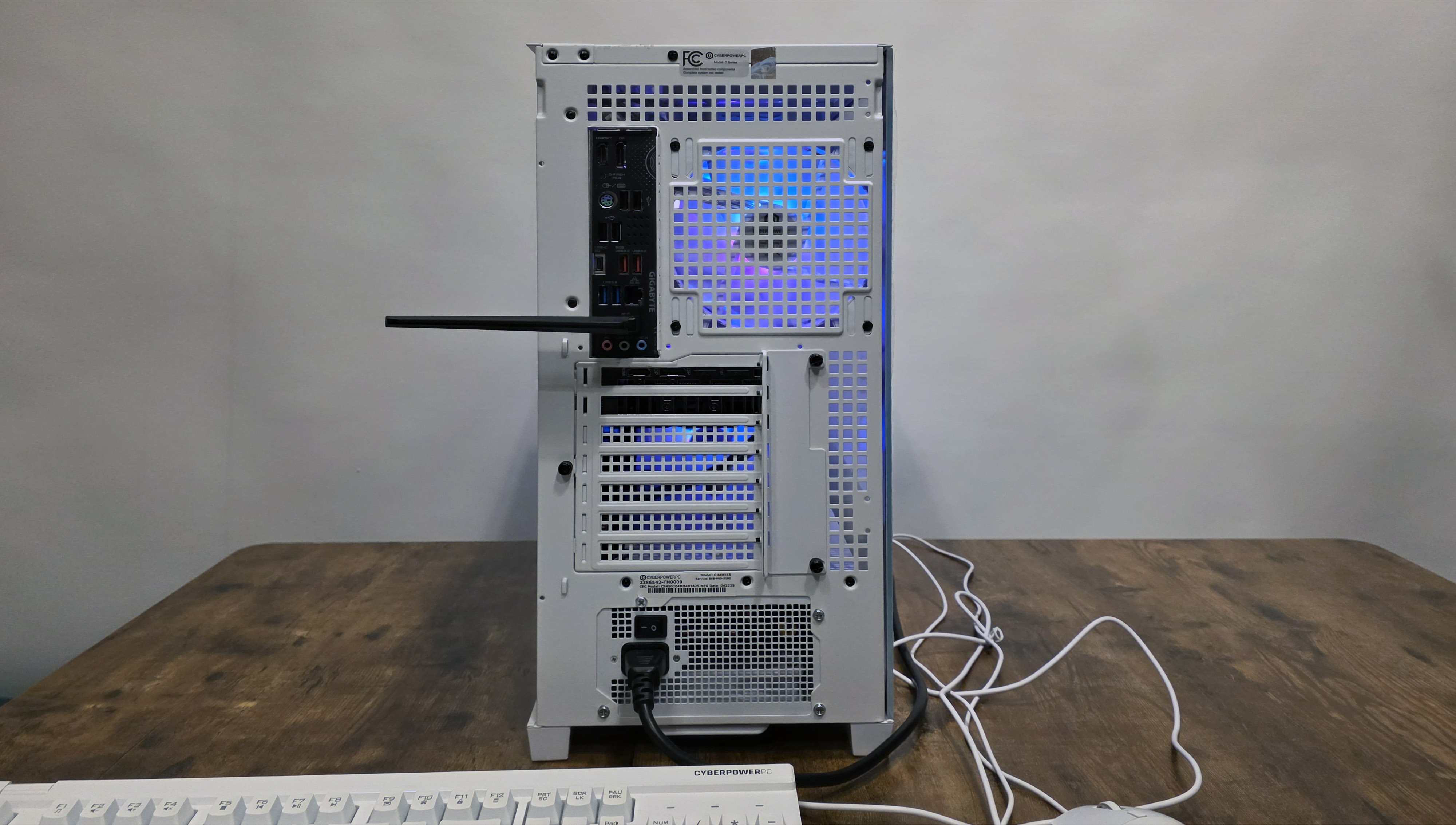
Around back, you get another 5 Gbps USB-C port, two faster 10 Gbs USB-A ports (in red), two 5 Gbps USB-A (blue), and four USB 2.0 Type-A ports (black). Also here is a simple three-port (mic, line out, line in) audio stack, the antenna plugs, and a PS/2 port for a jurassic peripheral. There are also HDMI and DisplayPorts here, but of course you'll want to plug your display(s) into the GPU.
The Asus-branded RTX 5060 Ti 16GB sports a single HDMI 2.1b port and three DisplayPorts.
Readers have commented in the past about the no-name or bargain-basement power supplies that often get used in prebuilts. The one installed in our review unit of the Gamer Supreme is a bit of a mixed bag. On the one hand, it's actually an 850W model, despite Nvidia recommending just 600W for a system with an RTX 5060 TI. And it's a non-modular model with a 12VHPWR connector, so this system is technically ready to handle a higher-end graphics card upgrade at some point.
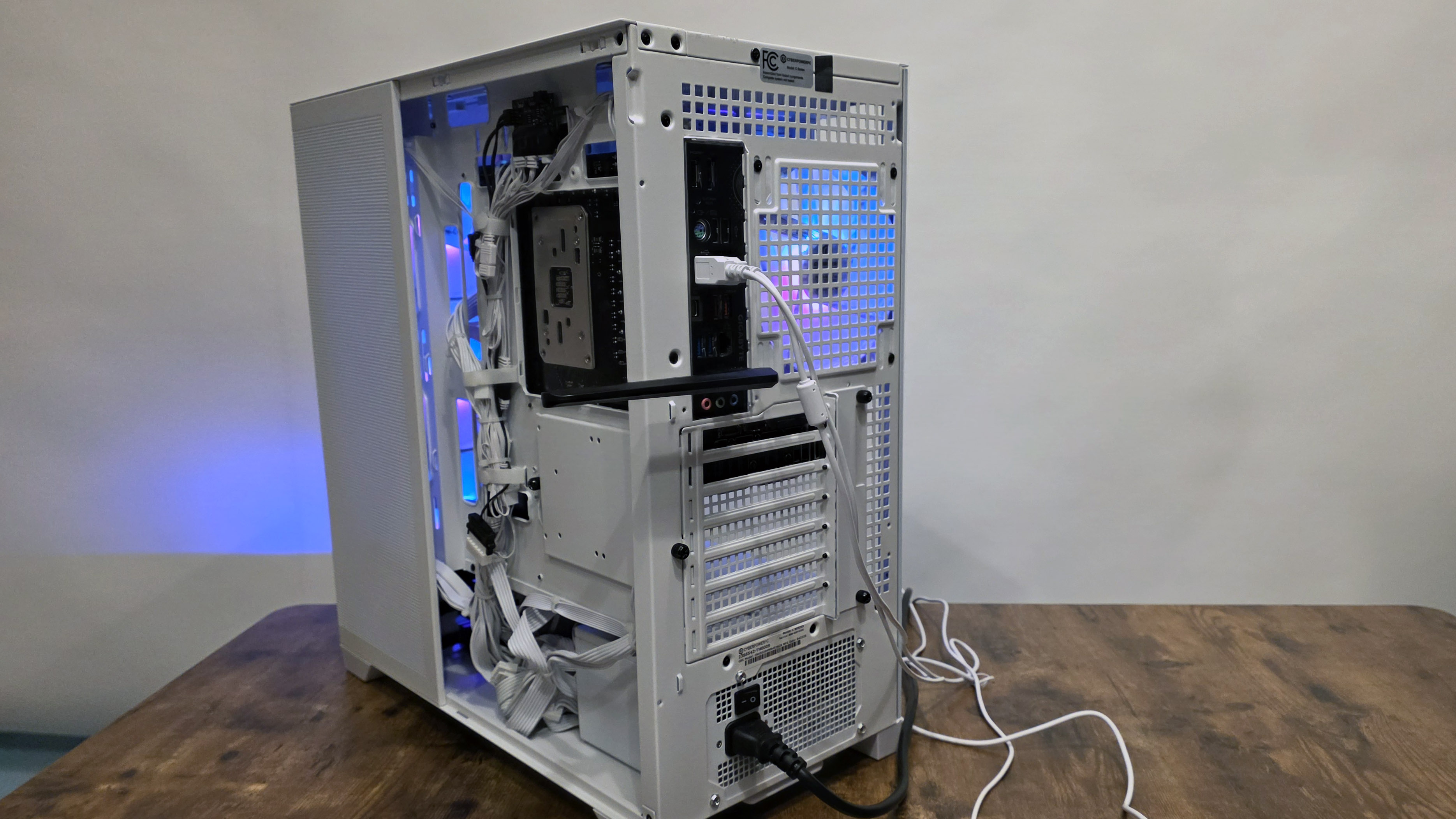
But don't expect a well-known or well-respected PSU brand here. Our review unit uses a High Power HP1-S2850GD-F12S, which claims an 80 Plus Gold efficiency rating, with Japanese "main capacitors." We had zero issues with the power supply in our testing, and the extra wattage overhead is certainly appreciated. But I'm sure many buyers would appreciate a more well-known brand.
The cable management looks a bit rushed, but is more or less in line with mainstream PCs from better-known brands. It kept the side panel from bulging, everything stayed connected as expected, and most users aren't ever going to look behind the motherboard unless something breaks, anyway. It's easily good enough.
Get Tom's Hardware's best news and in-depth reviews, straight to your inbox.
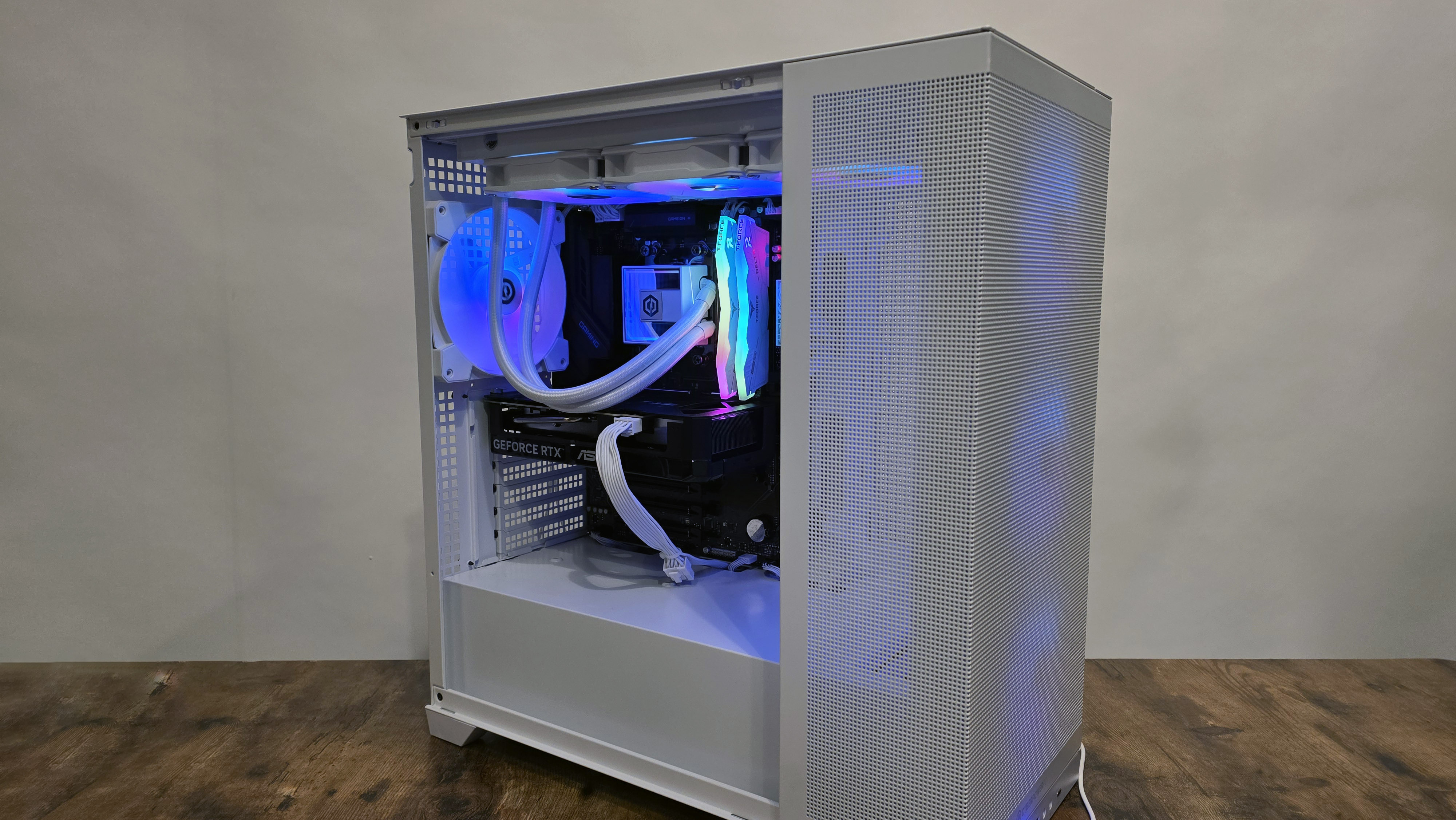
Gaming Performance on the CyberPowerPC Gamer Supreme
Though it's not a top-of-the-line gaming rig, CyberPowerPC's system includes the best CPU for gaming, AMD's Ryzen 7 9800X3D, paired with 32GB of RAM and a lower-end (but still plenty capable) RTX 5060 Ti. This is the first system we've tested with a current-gen Nvidia GPU in this price range, so this machine isn't going to dominate our benchmarks. But at under $1,900, it's also not going to dominate your wallet in the same way the Corsair Vengeance a7500 will, either (it was $2,799 with an RTX 5070 Ti, as tested).
We also compared the CyberPowerPC system to a Corsair system from late last year, the Vengeance i7600, with an RXT 4070 Super and an Intel Core Ultra 7 265K. That system was discounted to just $2,099 when we tested it, but that configuration is now out of stock at Best Buy and Corsair's web store.
Using the CyberPowerPC Gamer Supreme, I sliced, blocked, and punched my way through the Sentinel Barracks level of Doom: The Dark Ages. And while I had to dial the resolution down to 1440p and the settings defaulted to Medium, the game ran north of 70 frames per second, even in the most heated battles. The game often jumped into the triple digits when I wasn't surrounded by demons. Also important: the 360 mm AIO and case fans were barely louder than they were at the desktop while I played, even though I was running the game on mute on a quiet Monday in our office. If low-volume gaming is important to you, the Gamer Supreme is a good option, at least in this configuration.
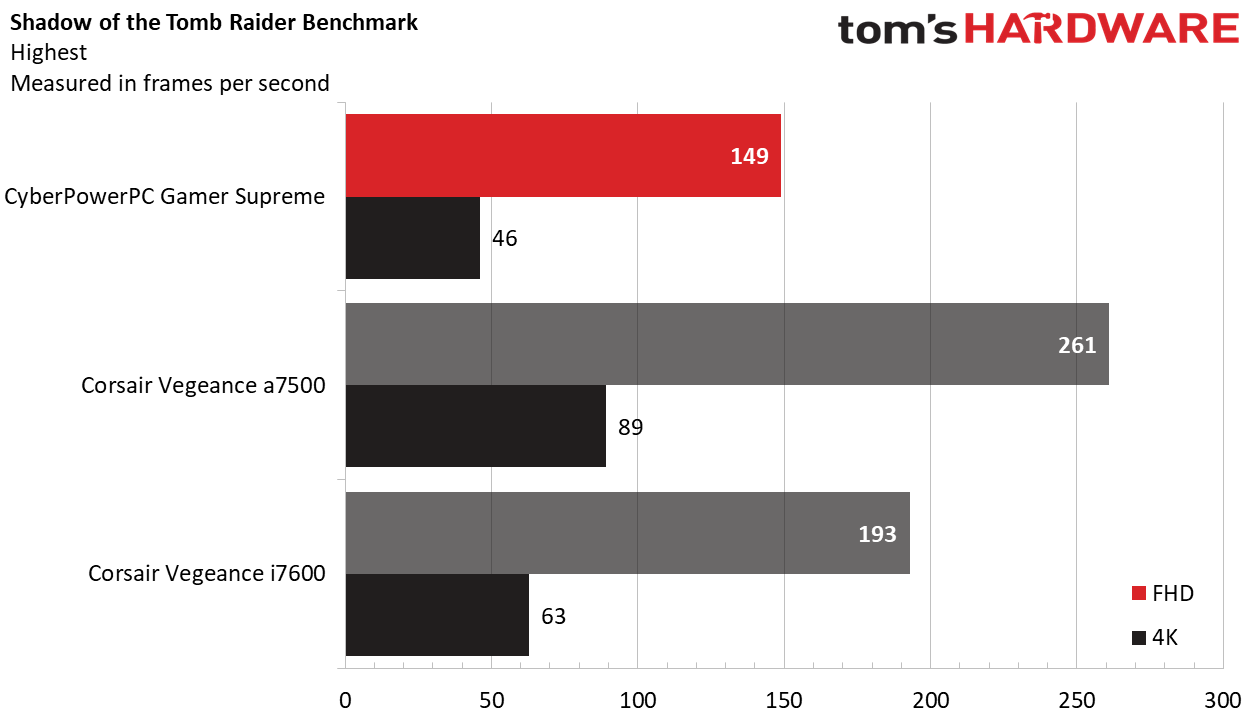
In Shadow of the Tomb Raider, using the game’s Highest detail preset, the Gamer Supreme was significantly behind the pricier competing systems, as expected. But at 149 FPS at 1080p, there is plenty of frame rate overhead. And even at 4K and 46 FPS, the game would clearly be playable by reducing a few settings.
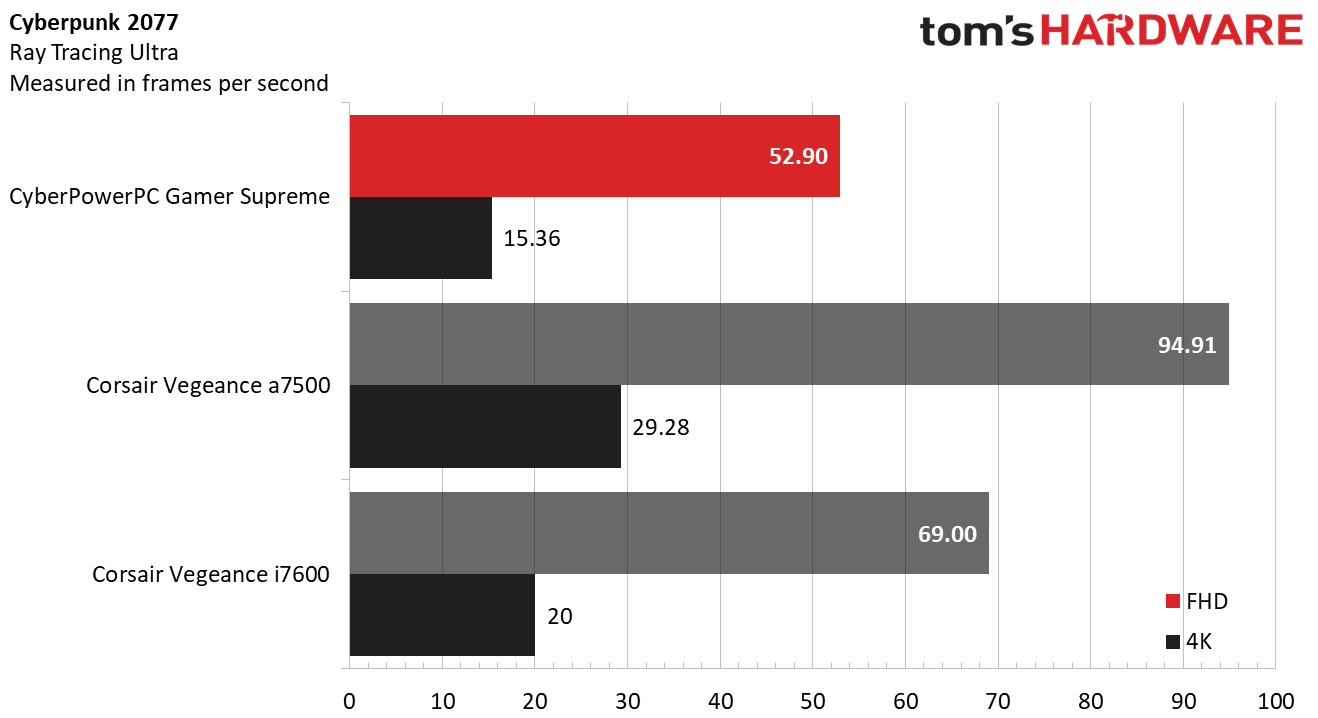
Shifting gears to the much more demanding Cyberpunk 2077 on the game’s Ray Tracing Ultra preset, the limitations of the Gamer Supreme's 5060 Ti are much more apparent. You'll definitely want to stick to 1080p with this title, and you'll want to knock some settings down or use some of Nvidia's software tricks to keep performance in the 60 FPS range.
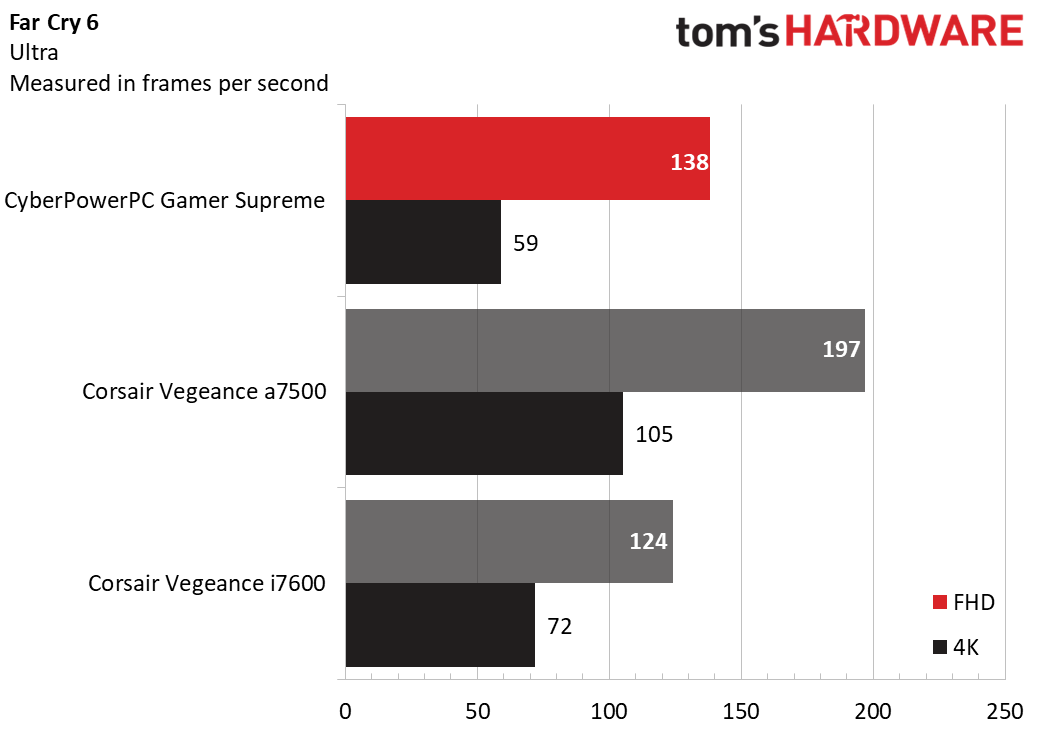
In Far Cry 6, at the game’s Ultra preset, the Gamer Supreme approaches 60 FPS at 4K, while easily maintaining triple digits at 1080p. In fact, its 138 FPS average manages to best the Vengeance i7600, which is bottlenecked by its Core Ultra CPU at tha resolution.
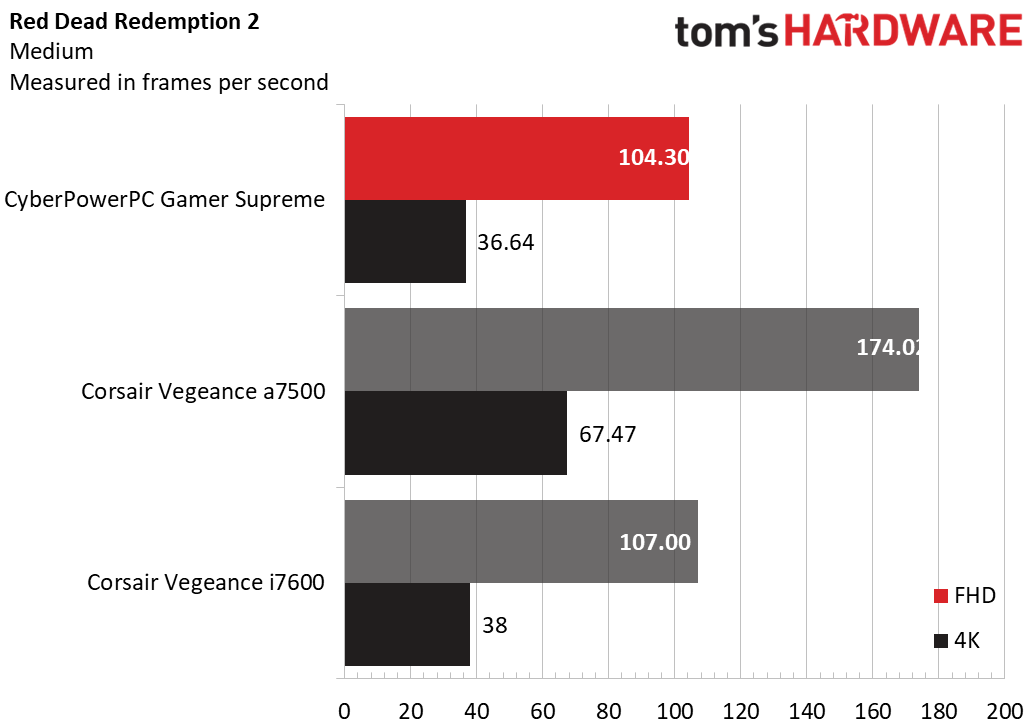
Again, the Gamer Supreme delivers similar performance to the Vengeance i7600 in Red Dead Redemption 2, using the game’s Medium preset — likely due to the latter's Intel CPU limiting frame rates. Still, you'll want to stick to 1080p or 1440p in this demanding game unless you have a more powerful graphics card, like the 5070 Ti in the Vengeance a7500.Lastly, in Borderlands 3, at the game’s Badass preset, we see a wider performance spread. But the Gamer Supreme easily achieves triple-digit frame rates at 1080p, and is close enough to 60 FPS at 4K that you could get there by disabling a few settings. Still, given the capabilities of the RTX 5060 Ti, expect to mostly stick to 1440p and 1080p with most demanding games.
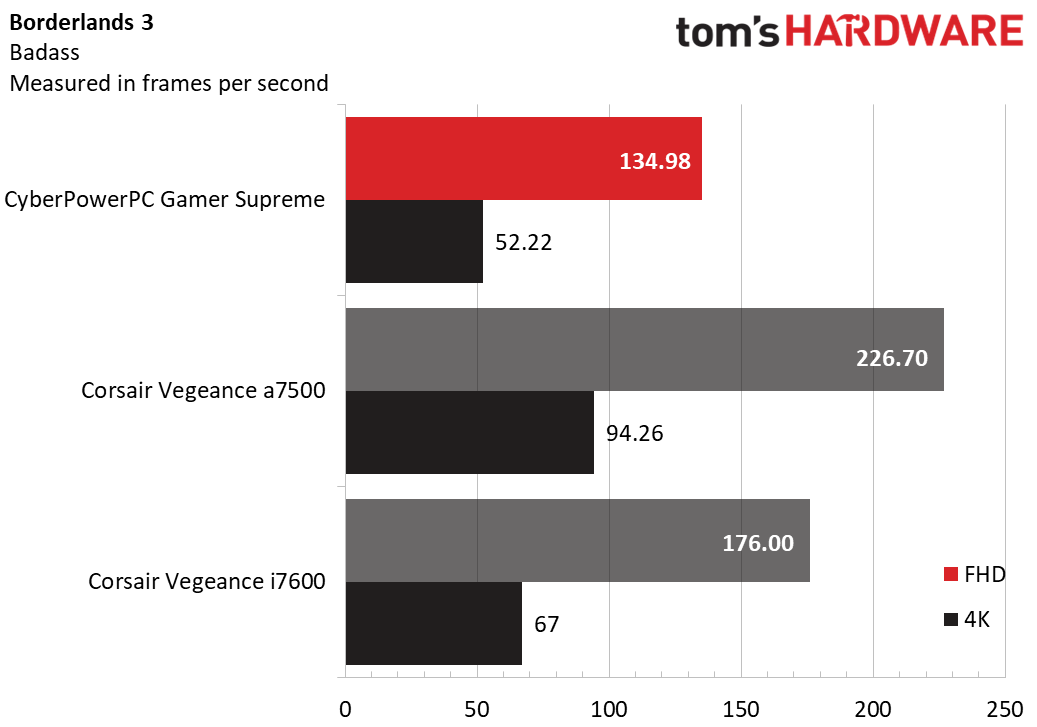
We use Metro Exodus to stress test gaming PCs, running a 15-loop marathon, to simulate a half hour of gaming. The CyberpowerPC Gamer Supreme averaged 145.88 frames per second (FPS), with effectively no variance, ranging from a low of 104.79 FPS and a high of 104.82. The Ryzen 7 9800X3D CPU maintained an average temperature of 46.48 degrees Celsius throughout the test, while the RTX 5060 Ti got a little warmer, at 61.82 degrees C. Both are well within the expected range, indicating the case and cooler are doing their job. And again, that job was accomplished quietly on our review unit.
Productivity Performance on the CyberPowerPC Gamer Supreme
While the Ryzen 7 9800X3D, 16GB of RAM, and a 2TB PCIe 4.0 SSD in the CyberPowerPC Gamer Supreme isn't the most potent productivity combo, that doesn't mean the system can't handle demanding tasks beyond just games. But if you want more memory or storage, the motherboard has two spare M.2 slots, and two RAM slots are unoccupied in this configuration.
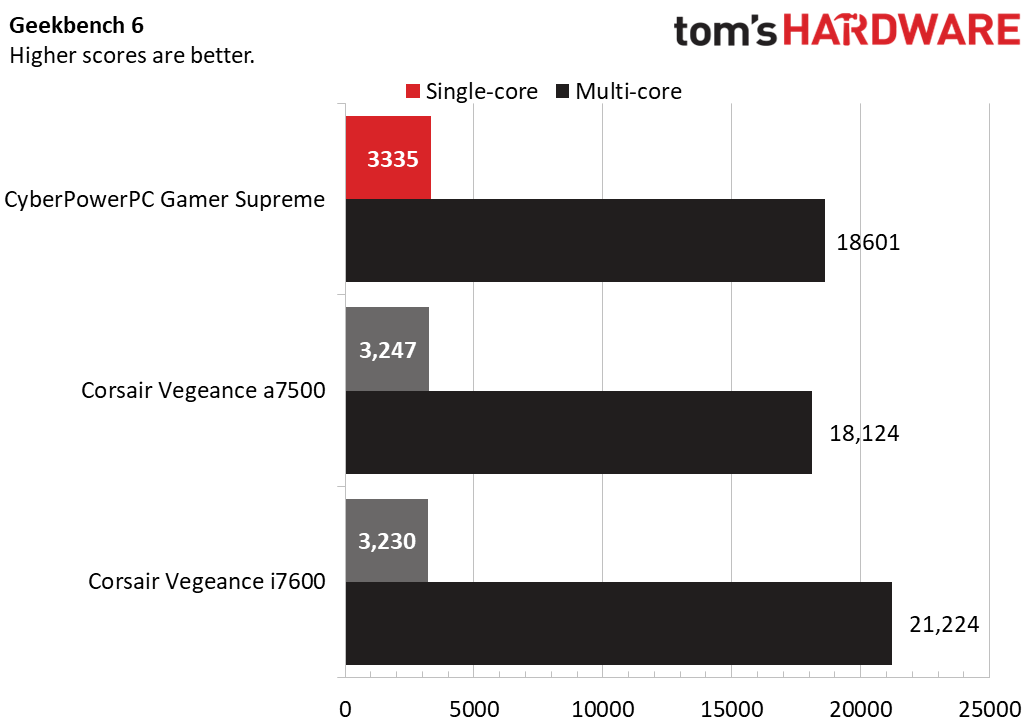
In the Geekbench 6 synthetic CPU benchmark, the Gamer Supreme's score of 3335 on the single-core side was enough to put it in the lead. It also edged past the Vengeance a7500 on the multi-core test slightly, despite both systems having the same CPU (perhaps a testament to the 360 mm AIO cooler on the Cyberpower system. The Vengeance i7600 and its Core Ultra 7 265K pulled ahead with its extra cores over the X3D AMD CPU, but not as far as you might think considering the Core Ultra chip has 12 more physical cores.
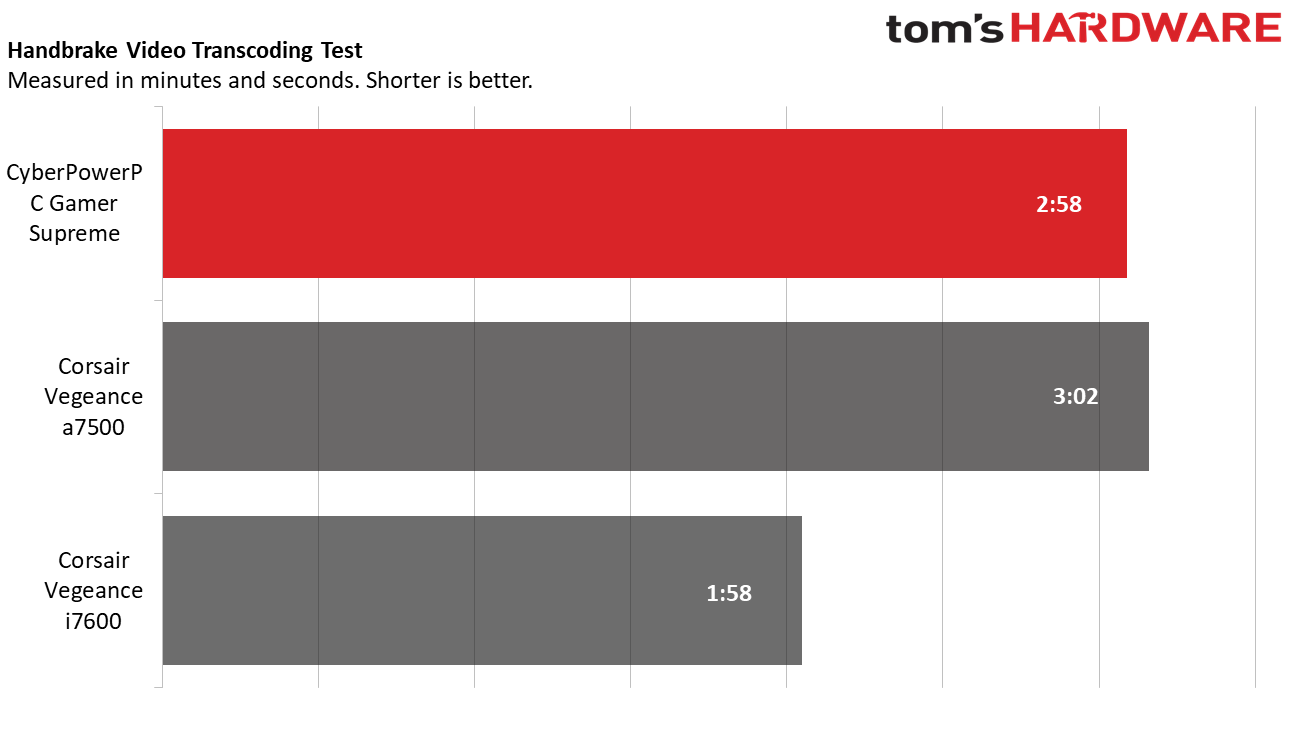
Intel's extra cores proved their worth, though, in our Handbrake test, which transcodes a 4K video to 1080p, with the Vengeance i7600 finishing in just under two minutes, while the two other Ryzen 7 9800X3D-powered systems took roughly a minute longer.
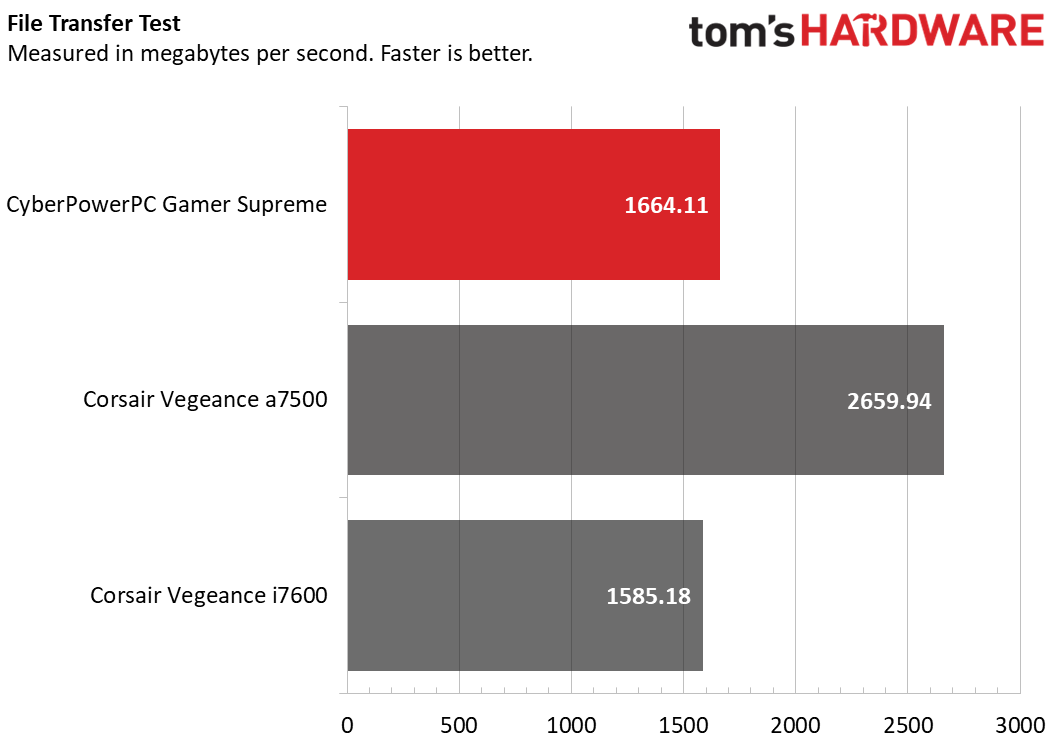
We also ran our 25 GB file transfer test on the primary storage drive. Here, the Gamer Supreme landed in second place, with a decent showing of 1,664.11 MBps with its ADATA PCIe 4.0 SSD. But the Corsair drive in the Vengeance a700 was much faster, delivering 2659.94 MBps on the same test.
CyberpowerPC Gamer Supreme Configurations
CyberpowerPC sells a large number of systems on its own site, but the Gamer Supreme is the company's retail line, available at stores like Walmart, Adorama, and Best Buy. The latter is where you'll find our review configuration, available for $1,859 when this was written. And even at Best Buy, we counted a whopping 94 different models, with prices ranging from $779 (Ryzen 5 5500, RX 6500 XT) to $5,099 (Ryzen 9 9950X, RTX 5090), with several different cases used across the expansive lineup. So if you don't like the looks of this model, or want something more or less powerful or affordable, there is no shortage of options with the Gamer Supreme lineup at Best Buy.
For mainstream gaming, the RTX 5060 Ti / Ryzen 7 9800X3D configuration we tested should serve you well. That said, if you're willing to go the Intel route, you can get a configuration with a Core i9 14900F and an RTX 5070 (a significantly more powerful GPU) for $1,899. That system also has what looks to be a nicer case, though it's black rather than white. The better GPU alone is easily worth the $40 price difference. But with 90 other models to choose from, depending on your budget, you could spend a lot of time narrowing down the best option for you.
As always, you can of course save money if you build your gaming PC yourself. To get a sense of how much Cyberpower charges for assembly (plus of course, the one-year warranty and customer service), I put together a similar build at Newegg, and wound up with a little over $1,600 worth of components in my cart – not counting Windows. So you're paying about $150 more than the cost of the parts, assuming you have to pay the retail price for Windows 11. That's not nothing, but it's not a lot if you're the kind of person who gets a lot more excited about gaming than about building.
Bottom Line
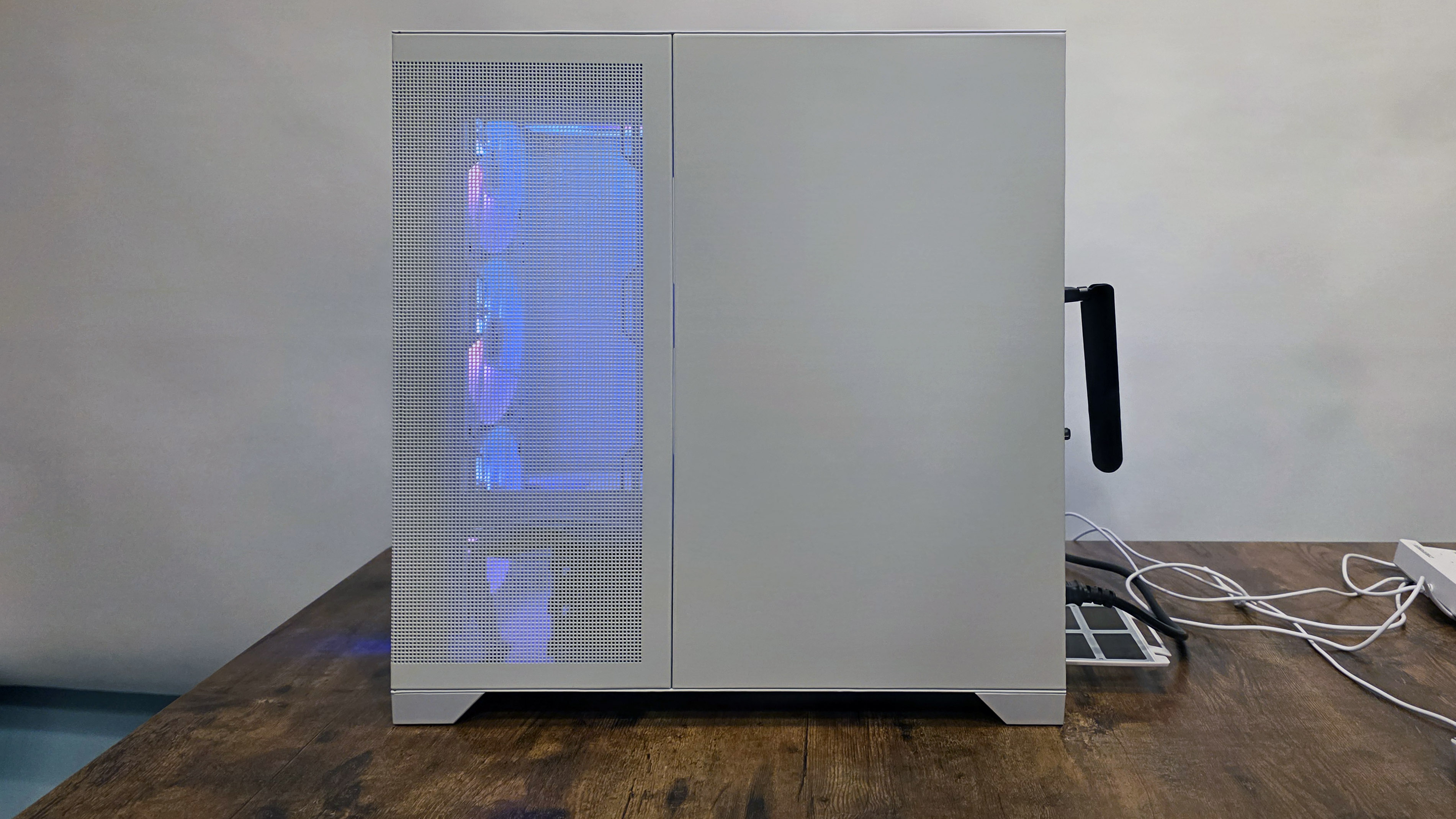
With the best gaming CPU and an RTX 5060 Ti (with 16GB of VRAM), the CyberPowerPC Gamer Supreme is a solid option for mainstream gaming, with a reasonable price of $1,859. If you spend a little more, you can find systems (CyberPowerPC or otherwise) with a more powerful RTX 5070 (though usually a somewhat worse CPU). But our review system was easily able to handle modern games so long as you weren't trying to play at 4K or always stay in the triple-digit FPS range.
I don't love the case that CyberPowerPC chose for this build, but there are dozens of other options available at Best Buy, and the included 360 mm AIO case fans did a good job of keeping things cool and quiet during gaming. If you want to play modern games with minimal noise and you don't want to spend more than $1,900, this Gamer Supreme should serve you well. Just leave some money in your budget to get a real mechanical keyboard.
After a rough start with the Mattel Aquarius as a child, Matt built his first PC in the late 1990s and ventured into mild PC modding in the early 2000s. He’s spent the last 15 years covering emerging technology for Smithsonian, Popular Science, and Consumer Reports, while testing components and PCs for Computer Shopper, PCMag and Digital Trends.
-
Roland Of Gilead So, although there are 94 options, are any of those configurable? Without the option to change, for example, the PSU, these do not appeal to me at all.Reply
I've only ever built my own PC's with one exception, which was a custom build. Total control over the parts used, and the extra cost is reflected in those parts. Custom Builds all the way. Prebuilts annoy me. -
VizzieTheViz Reply
If you’re able to and like to build your own pc that’s fine and will save you some money and give you a fun project to do.Roland Of Gilead said:So, although there are 94 options, are any of those configurable? Without the option to change, for example, the PSU, these do not appeal to me at all.
I've only ever built my own PC's with one exception, which was a custom build. Total control over the parts used, and the extra cost is reflected in those parts. Custom Builds all the way. Prebuilts annoy me.
This is not for you (or for me for that matter) but at least it’s a pretty decent solution for those that just want a pre made pc instead of a overpriced or unbalanced or both build you get from other brands (although I’d put more cash towards the gpu and less towards the cpu if I was putting together a gaming pc). -
ohio_buckeye Agreed or save money and toss in a 9700x for the cpu. Perfect pairing with a 9060xt or 5060ti, even really up to a 7900xtx probably. But for people looking for a gaming pc for a Christmas present for their kids that don’t know a lot about computers this is somewhat reasonable.Reply -
Roland Of Gilead Reply
Fair point.VizzieTheViz said:If you’re able to and like to build your own pc that’s fine and will save you some money and give you a fun project to do.
This is not for you (or for me for that matter) but at least it’s a pretty decent solution for those that just want a pre made pc instead of a overpriced or unbalanced or both build you get from other brands (although I’d put more cash towards the gpu and less towards the cpu if I was putting together a gaming pc). -
Roland Of Gilead Reply
Yes, agreed.ohio_buckeye said:Agreed or save money and toss in a 9700x for the cpu. Perfect pairing with a 9060xt or 5060ti, even really up to a 7900xtx probably. But for people looking for a gaming pc for a Christmas present for their kids that don’t know a lot about computers this is somewhat reasonable.
